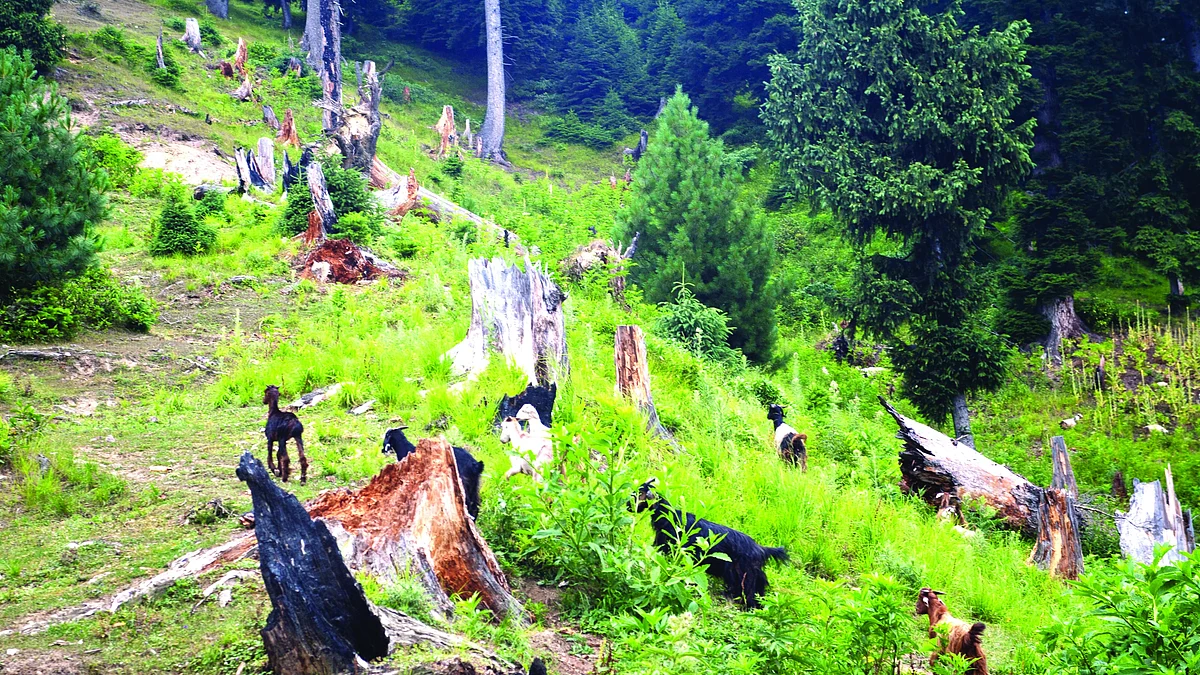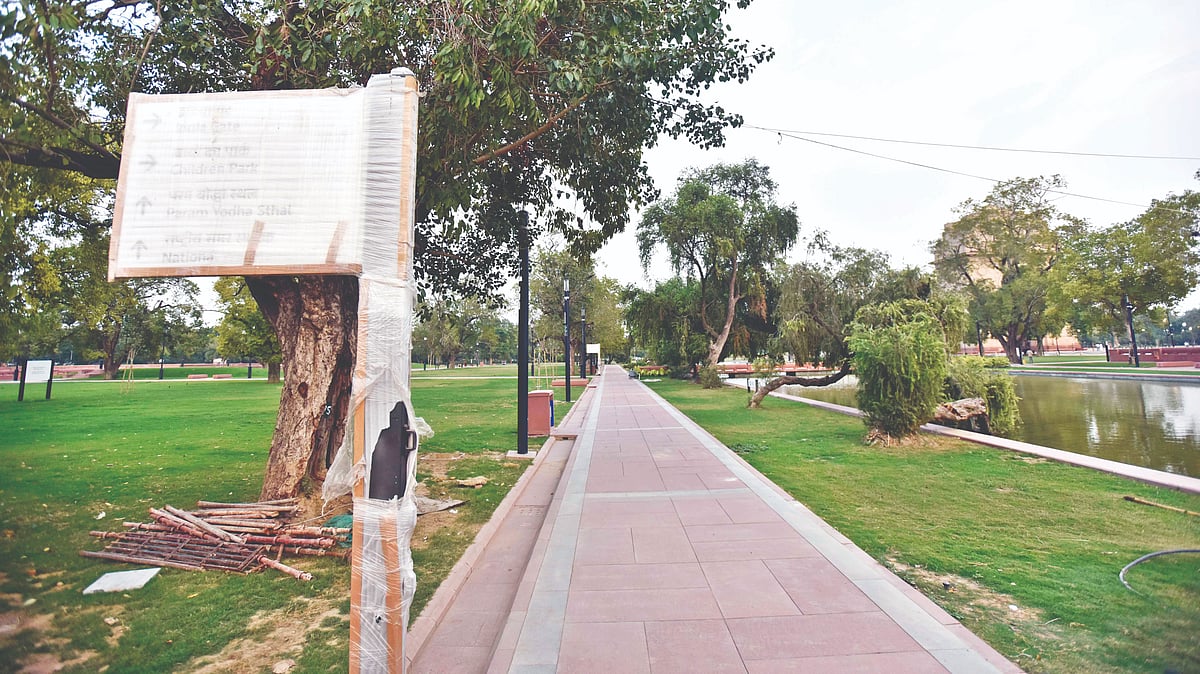Forests that grow only on paper
What emerges through a thicket of misinformation is that tree-planting schemes are more ‘greenwash’ than any good

While tree-planting schemes have been popular in several countries for the past several decades, doubts are increasingly being voiced about their efficacy. Experts have acknowledged that tree plantations or tree farms cannot be a substitute to natural forests, which support an entire ecosystem of plants, animals and insects.
A report in The New Yorker magazine this month raises similar doubts when it states that ‘it’s not clear that planting a trillion trees is a solution. […] killing forests and planting tree farms isn’t much help’.
National tree-planting schemes, this report notes, have historically come up short. Studies across countries have found that as many as nine in ten saplings planted under these schemes die. They are either the wrong kind of tree or are planted at the wrong place and at the wrong time of the year. Simply put, they do not improve forest cover.
But there is clearly money, big money, in trees. In 2020, the World Economic Forum announced sponsorship of an initiative called 1t, a corporate-funded plan to ‘conserve, restore, and grow’ one trillion trees by the year 2030. All the ‘strongmen’ of the world, Donald Trump and Narendra Modi included, are enthusiastic supporters and are being hailed as environmental champions.
The corporate sector’s love for trees isn’t new. In the US, the climate-change-denying Republican Party encouraged candidates for the US Congress to get themselves photographed planting a tree. The New Yorker report recalls a cartoon in which one suit (in a queue of businessmen patiently waiting to see a guru) says to another, ‘It’s great! You just tell him how much pollution your company is responsible for and he tells you how many trees you have to plant to atone for it.’
If only. Natural forests take hundreds of years to grow and while it is nice to hear that 10 trees are being planted for every tree that is felled, the entire strategy is a case of barking up the wrong tree (pun intended). Data can be fudged and it seems trees, like ponds, can grow on paper.
In India, forest-related data appears dodgy at best. Governments either do not have the precise data, despite satellite imagery, or they do not want to share them. When pushed for details, such are the various replies given by the government in Parliament:
2 February 2023: Environmental clearance was granted to fell 2.3 million trees between 2020 and 2022 for 31 highway projects, 11 ports, 15 airports, 20 river valley schemes and power plants. (written reply in the Rajya Sabha).
21 March 2022: Clearance was given to fell 3.97 million trees in 2020 and 2021. (reply in the Lok Sabha by minister of environment and forests Bupender Yadav).
10 February 2020: Clearance given to fell 7.67 million trees between 2016 and 2019. 3.3 million trees were felled in 2018–19 alone. (a reply in the Lok Sabha).
While it is possible that the right hand of the government is not aware of what the left hand is doing, what’s glaringly evident is that this information is actually misinformation. If permission was granted in 2020 to fell 2.3 million trees in three years and 3.97 million trees in two years, both figures cannot obviously be correct.
Nor does the government seem to have accurate data on how many trees are being planted. On 28 July 2022, junior environment minister Ashwini Kumar Choubey informed the Rajya Sabha that 54.5 million trees were planted in the past four years, 11 million of them in Uttar Pradesh alone. The minister also claimed that the survival rate of these trees ranged from 72 per cent in 2017–18 to 77.18 per cent in 2020–21.
The credibility of these figures is questioned by other reports which maintain that in Himachal Pradesh, the survival rate has been as low as three per cent, and that in Uttarakhand there is no more land to plant trees.

Himanshu Arora, a member of the organisation Citizens for Green Doon, is rightfully irked with the authorities: “If trees on 80 hectares of land are cleared, the same area of land should be made available for compensatory plantation. But if there is no land available, then why are they mindlessly destroying the existing forests?”
Delhi is possibly the only state in the country to have a policy on tree transplantation in place. Instead of the earlier norm of planting 10 trees for every tree felled, this policy prescribes transplantation of 80 per cent of the existing trees. It also acknowledges that only 37 per cent of the transplanted trees survive.
The survival rate is determined on the basis of plants which survive the first year; but experts point out that these figures are dubious because plants which have survived the first year may not survive the second. There is evidence that some of these plants have withered in subsequent years because of drought conditions and forest fires, for example.
Plantations in Himachal Pradesh were also destroyed by landslides. There is also no information on how much governments are spending on such transplantation programmes, what systems have been put in place to maintain and care for the newly transplanted trees, and who are the people carrying out these duties.
In 2015, the then minister for environment Prakash Javadekar had confided in a moment of candour that the survival rate of the government’s tree plantation schemes was just 10 to 20 per cent in most places. Researchers from Minnesota had also pointed out that many of the plants were not suitable for climatic conditions in India, and that the authorities had failed to identify the right places to plant the right trees.
Media reports on the government plan to fell forests over 130 sq. km in Nicobar Islands and compensate for them with tree plantations in the Aravallis in Haryana, 2,400 km away, have also caused considerable outrage. Haryana chief minister Manohar Lal Khattar is on record saying that Aravalli is on its way to becoming the world’s biggest ‘curated safari’.
Kanchi Kohli, senior researcher at the Centre for Policy Research, says the motivation for felling and planting trees is identical, namely to make money. If it’s any comfort, Kohli points out that the soil in Aravalli is dry and receives scanty rainfall, so grand plans to develop forests here for entertainment do not seem realistic.
***
Natural forest regeneration is increasingly catching the imagination of experts and activists alike. A BBC report titled ‘The messy alternative to tree-planting’, describes the process as one in which ‘trees are allowed to grow back spontaneously, or with limited human intervention, on land where the original forest cover had been cleared for uses such as agriculture or destroyed by fire. Trees grow from seeds blown in by the wind, carried there by animals or birds, or from plant parts such as stems, leaves or roots.’
The successful reforestation of the Sussex dairy farm featured in the report is not a one-off. Research by Robin Chazdon, professor emerita in the ecology and evolutionary biology department at the University of Connecticut, shows that natural forest regeneration has taken place in countries as diverse as Norway, Brazil, Costa Rica, Nepal and Ukraine.
But this has largely happened unintentionally, as people have abandoned farmland to move to more productive areas, or in search of jobs to cities. It is not clear if this can be replicated in India with its burgeoning population and misguided initiatives.
Follow us on: Facebook, Twitter, Google News, Instagram
Join our official telegram channel (@nationalherald) and stay updated with the latest headlines
